
Question Number 113211 by bemath last updated on 11/Sep/20
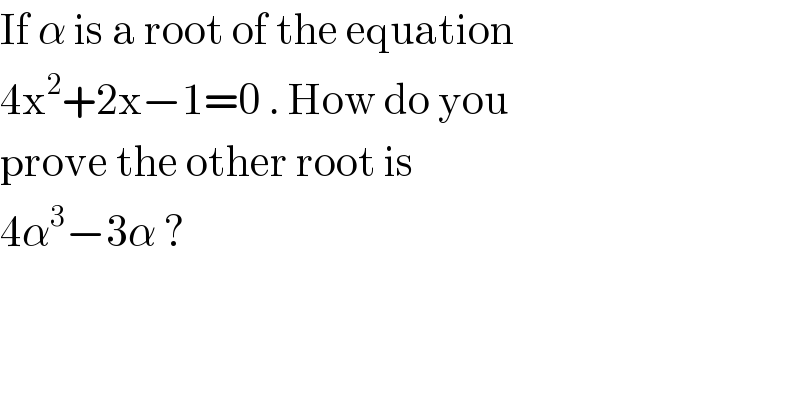
$$\mathrm{If}\:\alpha\:\mathrm{is}\:\mathrm{a}\:\mathrm{root}\:\mathrm{of}\:\mathrm{the}\:\mathrm{equation} \\ $$$$\mathrm{4x}^{\mathrm{2}} +\mathrm{2x}−\mathrm{1}=\mathrm{0}\:.\:\mathrm{How}\:\mathrm{do}\:\mathrm{you} \\ $$$$\mathrm{prove}\:\mathrm{the}\:\mathrm{other}\:\mathrm{root}\:\mathrm{is} \\ $$$$\mathrm{4}\alpha^{\mathrm{3}} −\mathrm{3}\alpha\:?\: \\ $$
Answered by 1549442205PVT last updated on 11/Sep/20
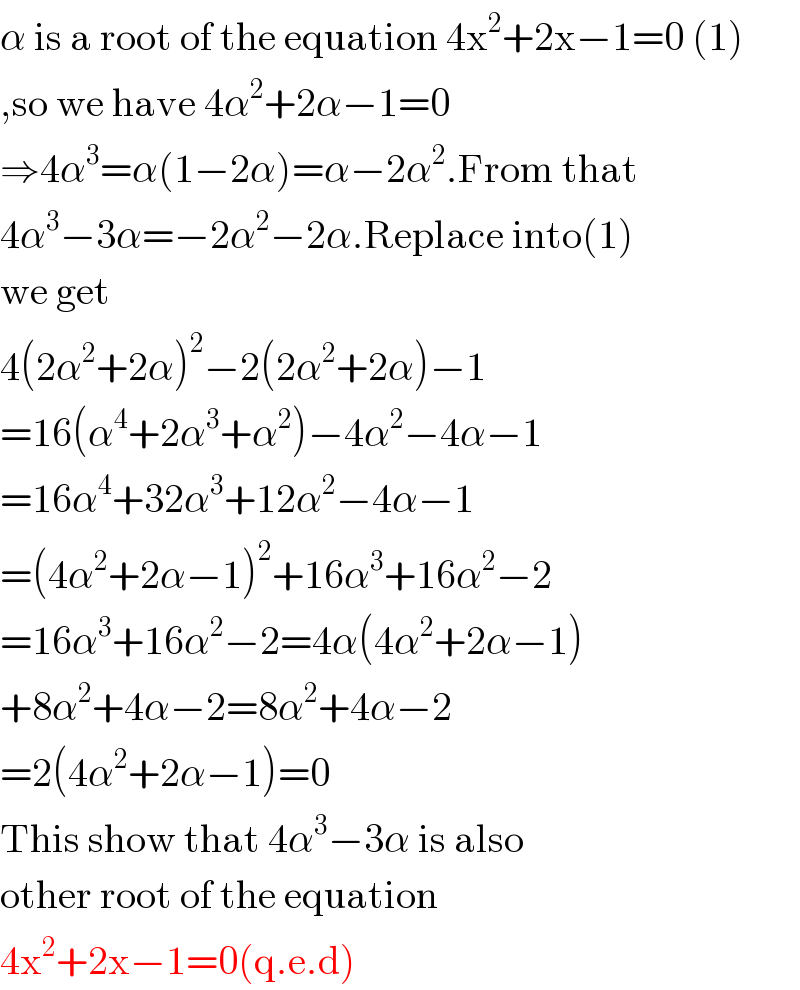
$$\alpha\:\mathrm{is}\:\mathrm{a}\:\mathrm{root}\:\mathrm{of}\:\mathrm{the}\:\mathrm{equation}\:\mathrm{4x}^{\mathrm{2}} +\mathrm{2x}−\mathrm{1}=\mathrm{0}\:\left(\mathrm{1}\right) \\ $$$$,\mathrm{so}\:\mathrm{we}\:\mathrm{have}\:\mathrm{4}\alpha^{\mathrm{2}} +\mathrm{2}\alpha−\mathrm{1}=\mathrm{0} \\ $$$$\Rightarrow\mathrm{4}\alpha^{\mathrm{3}} =\alpha\left(\mathrm{1}−\mathrm{2}\alpha\right)=\alpha−\mathrm{2}\alpha^{\mathrm{2}} .\mathrm{From}\:\mathrm{that} \\ $$$$\mathrm{4}\alpha^{\mathrm{3}} −\mathrm{3}\alpha=−\mathrm{2}\alpha^{\mathrm{2}} −\mathrm{2}\alpha.\mathrm{Replace}\:\mathrm{into}\left(\mathrm{1}\right) \\ $$$$\mathrm{we}\:\mathrm{get} \\ $$$$\mathrm{4}\left(\mathrm{2}\alpha^{\mathrm{2}} +\mathrm{2}\alpha\right)^{\mathrm{2}} −\mathrm{2}\left(\mathrm{2}\alpha^{\mathrm{2}} +\mathrm{2}\alpha\right)−\mathrm{1} \\ $$$$=\mathrm{16}\left(\alpha^{\mathrm{4}} +\mathrm{2}\alpha^{\mathrm{3}} +\alpha^{\mathrm{2}} \right)−\mathrm{4}\alpha^{\mathrm{2}} −\mathrm{4}\alpha−\mathrm{1} \\ $$$$=\mathrm{16}\alpha^{\mathrm{4}} +\mathrm{32}\alpha^{\mathrm{3}} +\mathrm{12}\alpha^{\mathrm{2}} −\mathrm{4}\alpha−\mathrm{1} \\ $$$$=\left(\mathrm{4}\alpha^{\mathrm{2}} +\mathrm{2}\alpha−\mathrm{1}\right)^{\mathrm{2}} +\mathrm{16}\alpha^{\mathrm{3}} +\mathrm{16}\alpha^{\mathrm{2}} −\mathrm{2} \\ $$$$=\mathrm{16}\alpha^{\mathrm{3}} +\mathrm{16}\alpha^{\mathrm{2}} −\mathrm{2}=\mathrm{4}\alpha\left(\mathrm{4}\alpha^{\mathrm{2}} +\mathrm{2}\alpha−\mathrm{1}\right) \\ $$$$+\mathrm{8}\alpha^{\mathrm{2}} +\mathrm{4}\alpha−\mathrm{2}=\mathrm{8}\alpha^{\mathrm{2}} +\mathrm{4}\alpha−\mathrm{2} \\ $$$$=\mathrm{2}\left(\mathrm{4}\alpha^{\mathrm{2}} +\mathrm{2}\alpha−\mathrm{1}\right)=\mathrm{0} \\ $$$$\mathrm{This}\:\mathrm{show}\:\mathrm{that}\:\mathrm{4}\alpha^{\mathrm{3}} −\mathrm{3}\alpha\:\mathrm{is}\:\mathrm{also} \\ $$$$\mathrm{other}\:\mathrm{root}\:\mathrm{of}\:\mathrm{the}\:\mathrm{equation} \\ $$$$\mathrm{4x}^{\mathrm{2}} +\mathrm{2x}−\mathrm{1}=\mathrm{0}\left(\mathrm{q}.\mathrm{e}.\mathrm{d}\right) \\ $$
Answered by $@y@m last updated on 11/Sep/20
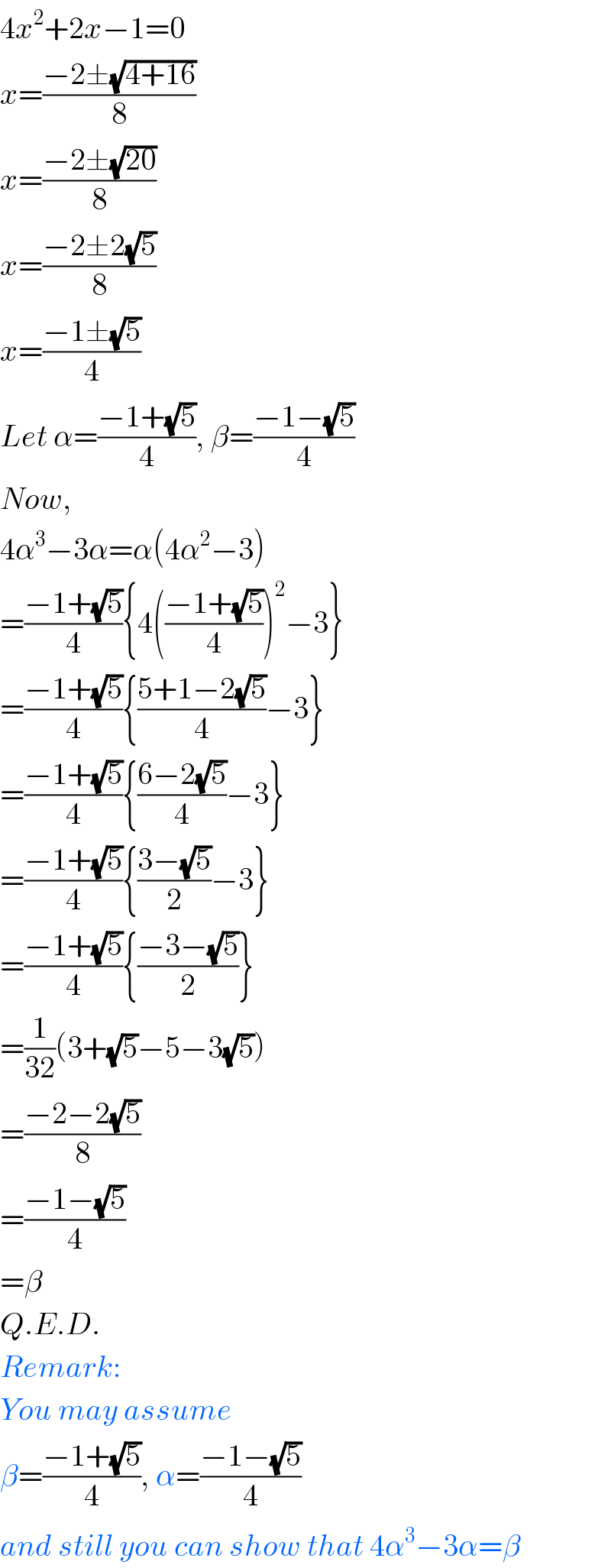
$$\mathrm{4}{x}^{\mathrm{2}} +\mathrm{2}{x}−\mathrm{1}=\mathrm{0} \\ $$$${x}=\frac{−\mathrm{2}\pm\sqrt{\mathrm{4}+\mathrm{16}}}{\mathrm{8}} \\ $$$${x}=\frac{−\mathrm{2}\pm\sqrt{\mathrm{20}}}{\mathrm{8}} \\ $$$${x}=\frac{−\mathrm{2}\pm\mathrm{2}\sqrt{\mathrm{5}}}{\mathrm{8}} \\ $$$${x}=\frac{−\mathrm{1}\pm\sqrt{\mathrm{5}}}{\mathrm{4}} \\ $$$${Let}\:\alpha=\frac{−\mathrm{1}+\sqrt{\mathrm{5}}}{\mathrm{4}},\:\beta=\frac{−\mathrm{1}−\sqrt{\mathrm{5}}}{\mathrm{4}} \\ $$$${Now}, \\ $$$$\mathrm{4}\alpha^{\mathrm{3}} −\mathrm{3}\alpha=\alpha\left(\mathrm{4}\alpha^{\mathrm{2}} −\mathrm{3}\right) \\ $$$$=\frac{−\mathrm{1}+\sqrt{\mathrm{5}}}{\mathrm{4}}\left\{\mathrm{4}\left(\frac{−\mathrm{1}+\sqrt{\mathrm{5}}}{\mathrm{4}}\right)^{\mathrm{2}} −\mathrm{3}\right\} \\ $$$$=\frac{−\mathrm{1}+\sqrt{\mathrm{5}}}{\mathrm{4}}\left\{\frac{\mathrm{5}+\mathrm{1}−\mathrm{2}\sqrt{\mathrm{5}}}{\mathrm{4}}−\mathrm{3}\right\} \\ $$$$=\frac{−\mathrm{1}+\sqrt{\mathrm{5}}}{\mathrm{4}}\left\{\frac{\mathrm{6}−\mathrm{2}\sqrt{\mathrm{5}}}{\mathrm{4}}−\mathrm{3}\right\} \\ $$$$=\frac{−\mathrm{1}+\sqrt{\mathrm{5}}}{\mathrm{4}}\left\{\frac{\mathrm{3}−\sqrt{\mathrm{5}}}{\mathrm{2}}−\mathrm{3}\right\} \\ $$$$=\frac{−\mathrm{1}+\sqrt{\mathrm{5}}}{\mathrm{4}}\left\{\frac{−\mathrm{3}−\sqrt{\mathrm{5}}}{\mathrm{2}}\right\} \\ $$$$=\frac{\mathrm{1}}{\mathrm{32}}\left(\mathrm{3}+\sqrt{\mathrm{5}}−\mathrm{5}−\mathrm{3}\sqrt{\mathrm{5}}\right) \\ $$$$=\frac{−\mathrm{2}−\mathrm{2}\sqrt{\mathrm{5}}}{\mathrm{8}} \\ $$$$=\frac{−\mathrm{1}−\sqrt{\mathrm{5}}}{\mathrm{4}} \\ $$$$=\beta \\ $$$${Q}.{E}.{D}. \\ $$$${Remark}: \\ $$$${You}\:{may}\:{assume}\: \\ $$$$\beta=\frac{−\mathrm{1}+\sqrt{\mathrm{5}}}{\mathrm{4}},\:\alpha=\frac{−\mathrm{1}−\sqrt{\mathrm{5}}}{\mathrm{4}} \\ $$$${and}\:{still}\:{you}\:{can}\:{show}\:{that}\:\mathrm{4}\alpha^{\mathrm{3}} −\mathrm{3}\alpha=\beta \\ $$
Commented by 1549442205PVT last updated on 12/Sep/20
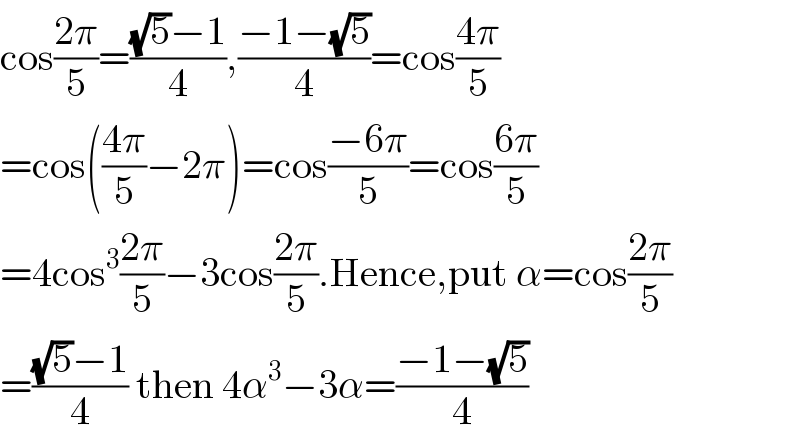
$$\mathrm{cos}\frac{\mathrm{2}\pi}{\mathrm{5}}=\frac{\sqrt{\mathrm{5}}−\mathrm{1}}{\mathrm{4}},\frac{−\mathrm{1}−\sqrt{\mathrm{5}}}{\mathrm{4}}=\mathrm{cos}\frac{\mathrm{4}\pi}{\mathrm{5}} \\ $$$$=\mathrm{cos}\left(\frac{\mathrm{4}\pi}{\mathrm{5}}−\mathrm{2}\pi\right)=\mathrm{cos}\frac{−\mathrm{6}\pi}{\mathrm{5}}=\mathrm{cos}\frac{\mathrm{6}\pi}{\mathrm{5}} \\ $$$$=\mathrm{4cos}^{\mathrm{3}} \frac{\mathrm{2}\pi}{\mathrm{5}}−\mathrm{3cos}\frac{\mathrm{2}\pi}{\mathrm{5}}.\mathrm{Hence},\mathrm{put}\:\alpha=\mathrm{cos}\frac{\mathrm{2}\pi}{\mathrm{5}} \\ $$$$=\frac{\sqrt{\mathrm{5}}−\mathrm{1}}{\mathrm{4}}\:\mathrm{then}\:\mathrm{4}\alpha^{\mathrm{3}} −\mathrm{3}\alpha=\frac{−\mathrm{1}−\sqrt{\mathrm{5}}}{\mathrm{4}} \\ $$
Answered by Dwaipayan Shikari last updated on 11/Sep/20
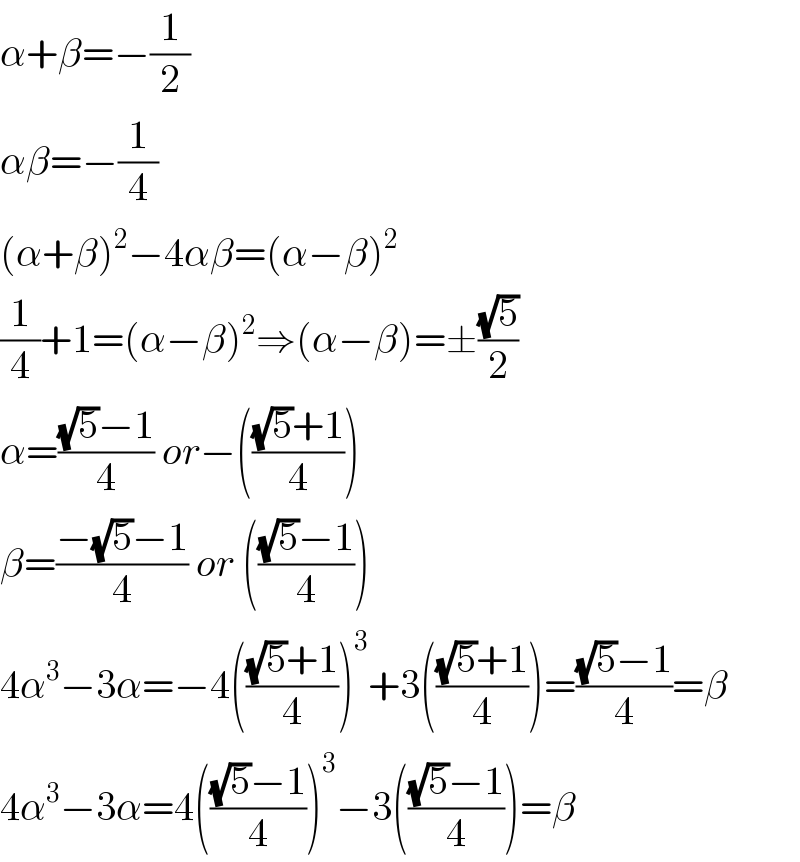
$$\alpha+\beta=−\frac{\mathrm{1}}{\mathrm{2}} \\ $$$$\alpha\beta=−\frac{\mathrm{1}}{\mathrm{4}} \\ $$$$\left(\alpha+\beta\right)^{\mathrm{2}} −\mathrm{4}\alpha\beta=\left(\alpha−\beta\right)^{\mathrm{2}} \\ $$$$\frac{\mathrm{1}}{\mathrm{4}}+\mathrm{1}=\left(\alpha−\beta\right)^{\mathrm{2}} \Rightarrow\left(\alpha−\beta\right)=\pm\frac{\sqrt{\mathrm{5}}}{\mathrm{2}} \\ $$$$\alpha=\frac{\sqrt{\mathrm{5}}−\mathrm{1}}{\mathrm{4}}\:{or}−\left(\frac{\sqrt{\mathrm{5}}+\mathrm{1}}{\mathrm{4}}\right) \\ $$$$\beta=\frac{−\sqrt{\mathrm{5}}−\mathrm{1}}{\mathrm{4}}\:{or}\:\left(\frac{\sqrt{\mathrm{5}}−\mathrm{1}}{\mathrm{4}}\right) \\ $$$$\mathrm{4}\alpha^{\mathrm{3}} −\mathrm{3}\alpha=−\mathrm{4}\left(\frac{\sqrt{\mathrm{5}}+\mathrm{1}}{\mathrm{4}}\right)^{\mathrm{3}} +\mathrm{3}\left(\frac{\sqrt{\mathrm{5}}+\mathrm{1}}{\mathrm{4}}\right)=\frac{\sqrt{\mathrm{5}}−\mathrm{1}}{\mathrm{4}}=\beta \\ $$$$\mathrm{4}\alpha^{\mathrm{3}} −\mathrm{3}\alpha=\mathrm{4}\left(\frac{\sqrt{\mathrm{5}}−\mathrm{1}}{\mathrm{4}}\right)^{\mathrm{3}} −\mathrm{3}\left(\frac{\sqrt{\mathrm{5}}−\mathrm{1}}{\mathrm{4}}\right)=\beta \\ $$
